Bireswar Sen- the wayfaring artist from Bengal
(Reading Time: 12 min Approx)
It was not dark yet. There was a slight chill in the dusky air. The town of Naggar cradled within the mountains of Kullu was still reveling in the last few days of autumn. It was a small town; not much to boast of except the traditional cloth mills, a modest public library, a post office and the pristine mountains with its benign folks.
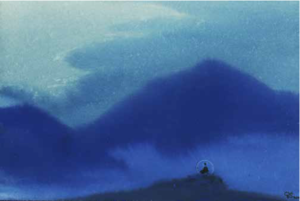
A young artist had come here all the way from Bengal, sat with his steaming glass of tea, taking in the serene grandeur around him. He had come to Naggar that very afternoon and was out for a stroll on the roads that snaked their way across the hill town. After walking a while, he found that the road split; one end went down the hill, the other went upwards forming a muddy staircase. Out of curiosity he went up the crooked stairs and found a sprawling stall attached to a small house run by a middle-aged couple.
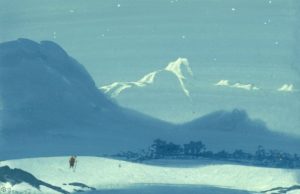
The owner and his wife, besides running the stall, took care of their garden behind their house. They had a couple of dogs and a few cats. The artist requested for a ginger tea and looked around to notice that there were very few people. Perhaps not many pedestrians had cared enough to walk up the stairs to this tiny hill top. One or two solitary travelers and locals wandered around the spot and they seemed to be quite familiar with the friendly couple.
Tea in hand, the young traveler gazed at the sight beside the stall in muted silence.
“Have you ever heard of Shambhala?” The query came from behind. The startled artist turned around to find a foreigner in a white beard dressed in the local attire and a Kullu Patti. He was not looking at the artist; he was staring ahead at the snowy landscape.
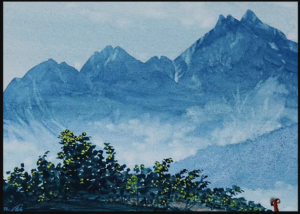
The artist fumbled for words and answered hesitantly, “No, I have not. Where is it?”
The stranger replied, “I’m on a quest for Shambhala and the beyuls that lie within these valleys. Would you care to join me?”
Perhaps this is how they met; the Bengali artist, Bireswar Sen and the foreigner in the Kullu attire, Nicholas Roerich.
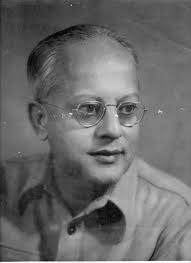
Not many people of and outside the avant-garde of Bengal art community are aware of the life and works of Bireswar Sen.
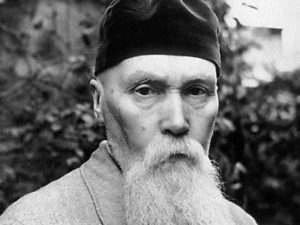
Bireswar Sen was born in 1897 at Kolkata to Mrs. Niharnalini Sen and Rai Bahadur Saileshwar Sen. He orbited into the circles of Indian Society of Oriental Art in Kolkata in 1917 and came in contact with Abanindranath Tagore and Nandalal Bose. He obtained his M.A. in English Literature from the Presidency College Kolkata in 1921 and was appointed as a lecturer in English at the B. N. College, Patna in 1923.
He had taken lessons on art from the best i.e. Aban Thakur, Nandalal Bose, Gaganendranath Tagore, Japanese masters Taikan and Kampo Arai who had come to Kolkata to Shantiniketan along with Okakura Kakuzo. Even after moving to Patna in order to pursue a career in English Literature he kept in touch with painting.
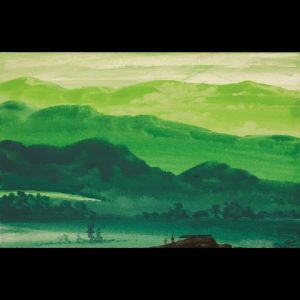
He was very much influenced by the ‘wash’ technique in watercolor widely used by his gurus at Shantiniketan and the Nihonga technique from the Japanese artists who visited Shantiniketan. His initial artworks reflect his tendency to imitate the style of his masters.
But later in life he developed his own signature idiom after meeting Nicholas Roerich; a meeting which proved to be the turning point in his life. Nicholas Roerich was a Russian theosophist, visionary, artist, peace builder and seeker. In 1923 he traveled to the Himalayas with his family in search for Shambhala or Shangri-La. After many expeditions he finally settled in the Naggar valley of Kullu in Himachal Pradesh.
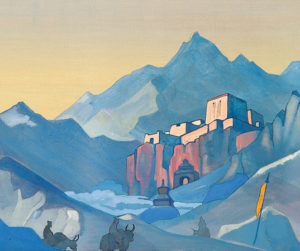
Bireswar Sen was moved by Roerich’s spiritual vision and his artworks. He was smitten with the allure of the majestic Himalayas that seemed to inhabit Roerich’s paintings. He stayed in the Kullu valley with the Roerich family and traveled to Kashmir to capture the essence of the mountains in his paintings.
Bireswar Sen had an eclectic schooling in art. He had learned from the masters of Bengal, Japan and Russia. Due to which he was caught in an artistic dilemma for many years. However, after his meeting with Roerich and their expedition to the Garhwal region Bireswar Sen resolved to develop his unique expressionism through his paintings; to leave his own imprint. He traveled extensively across solitary valleys, country sides and made notes, observed the visual details. He decided not to imitate nature but to reproduce his own version of nature in his paintings. He painted from his recollections, memories of the places he went to.
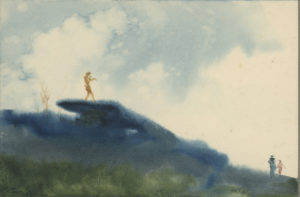
B. N. Goswamy cited from one of Sen’s articles: “..the artist first selects the essentials and rejects the unnecessary and the irrelevant. Art is a selection from and not an imitation of nature”, “an addition to or exaggeration of nature”. Besides his selective portrayal of the mountains and valleys, he included the one thing that made his paintings seem like a paused movie i.e. the mind and soul of a human being. His paintings were never bigger than postcard, maybe smaller at times. Sen surely had to master a great skill i.e. to miniaturize the breathtaking beauty of the Himalayas and yet consciously articulate every detail and blend colors in an impeccable manner. The minuscule figures in his painting can only be located if looked at very closely or with a magnifying glass; a pilgrim inside a cave, a couple walking towards the forest, a woman walking across a field her sari fluttering in the wind, a boy playing the flute on a mountain rock, a traveler wading through the snow with his mule.
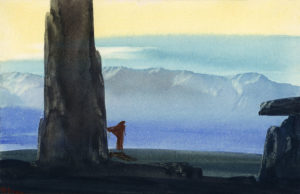
Besides being a painter, Sen also possessed the soul of a poet who liked engaging in assigning lyrical captions to his artworks. For e.g. A Pearl Grey Afternoon, Now for a Quiet Dip, Sleep, Beloved, Flowering Kasha Reeds, The Dweller of the Ruined Temple, One Misty Moisty Morning.
After coming in touch with Nicholas Roerich who was immersed in seeking Shambhala (a fictional, Utopian place where happiness dwelt eternally according to Tibetan scriptures), perhaps Bireswar Sen too was caught up with the idea of finding inner peace and fulfillment in solitude. Most of his paintings portray solitary ascetics in the cradle of valleys, caves and mountains. The composition and color scheme infuse an aura of serenity and grandeur in his paintings, simultaneously. Despite being no bigger than a playing card, they contain the power to command the rapture of art lovers.
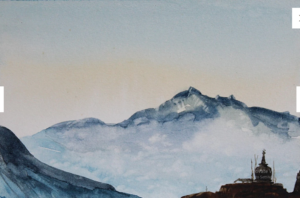
Sen held numerous positions throughout his life and his artworks were acquired by the Central Museum at Lahore, National Gallery of Modern Art at New Delhi, the Provincial Museum of Lucknow, and the State Gallery at Mysore etc. Solo exhibitions of his paintings were held at London, Japan, Tokyo, Berlin, Paris, Lahore, Shimla, Darjeeling, New Delhi and Nainital among other venues.
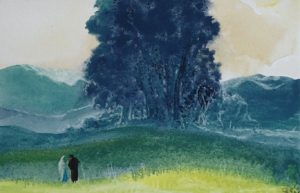
The timelessness, tranquility and magnificence in Bireswar Sen’s miniature landscape paintings cannot be comprehended just through words, so it is better to let the artworks do the talking.
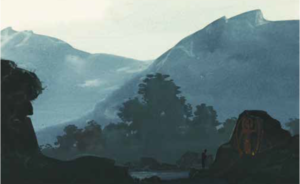
References: Time And Eternity: Landscape Paintings by Bireswar Sen, With an Essay by B. N. Goswamy, Crow Collection of Asian Art Dallas, Texas, Printed in Collaboration with the Bireswar Family Trust.
Quotations cited from the essay by B. N. Goswamy in Time and Eternity.
All pictorial credits and rights belong to the Bireswar Sen Family Trust and the Nicholas Roerich Museum.
https://www.bireswarsenart.com/

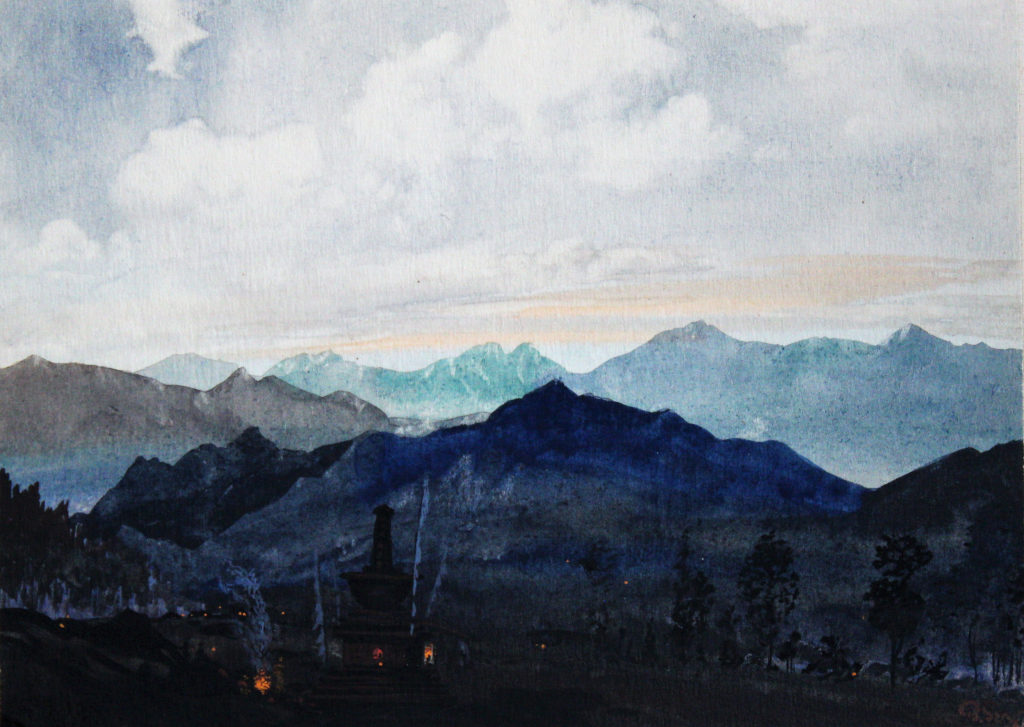
The miniatures of the Indian Master Bireswar Sen looks in total contrast to those of Russian Master Nicholas Roerich. Bireswar Sen’s work are soaked in wonder , beauty & deep rooted philosophy while Nicholas Roerich expressed his love for Himalayas mostly in big canvases & in blazing colours.